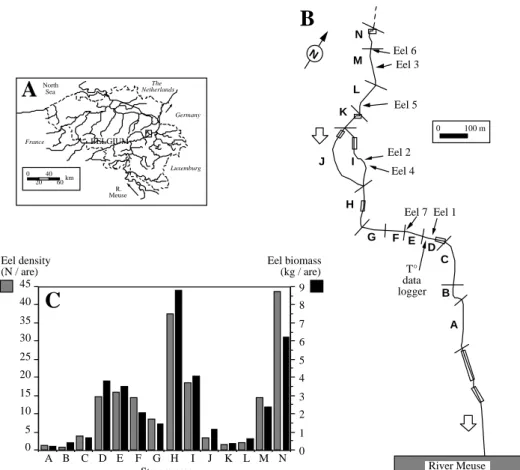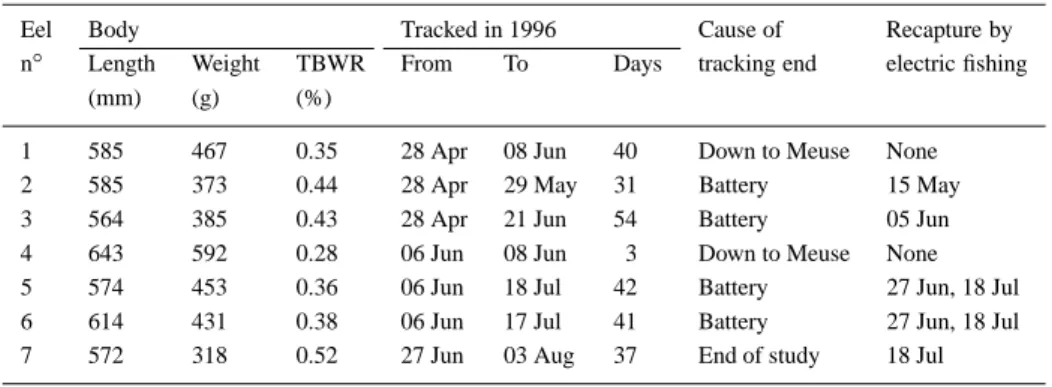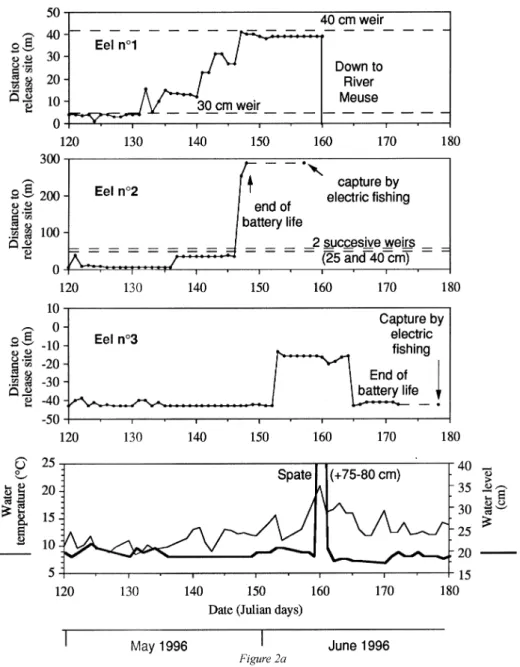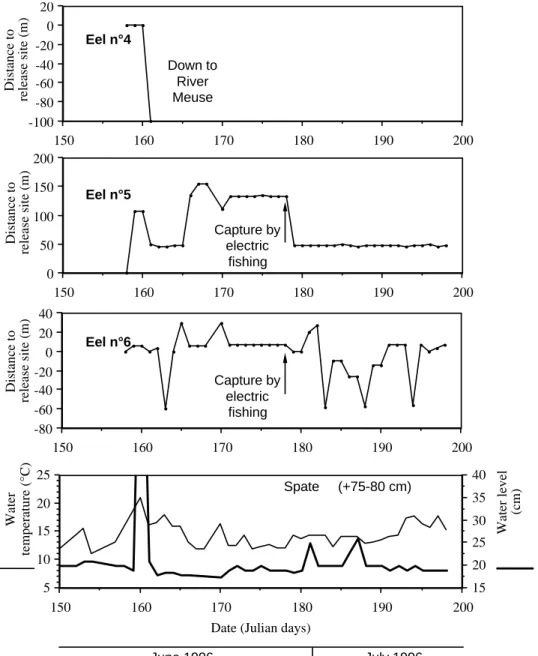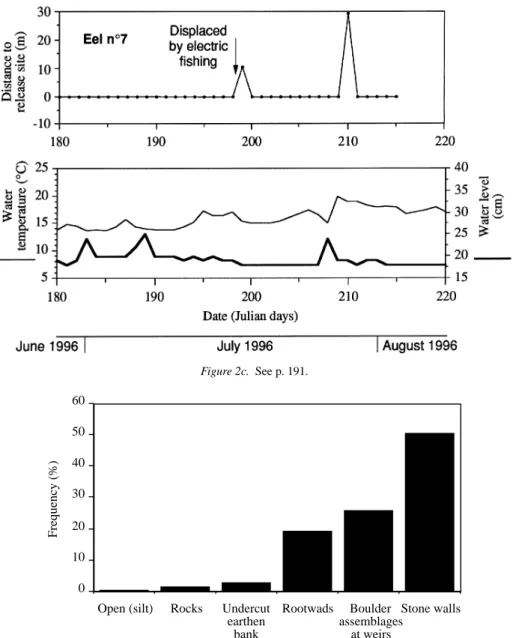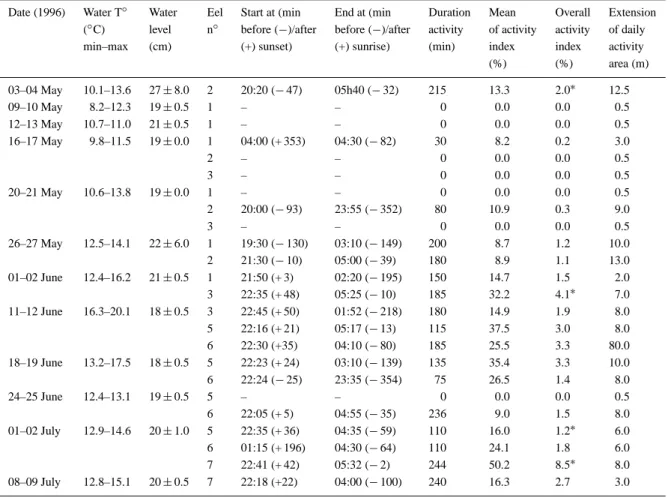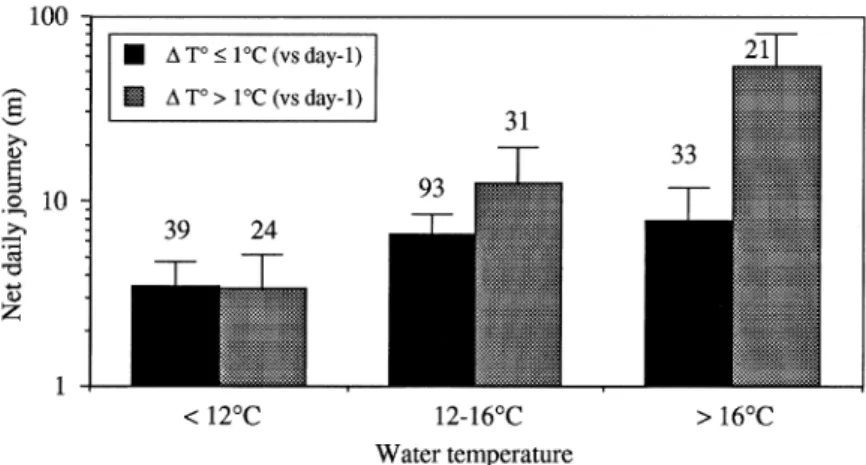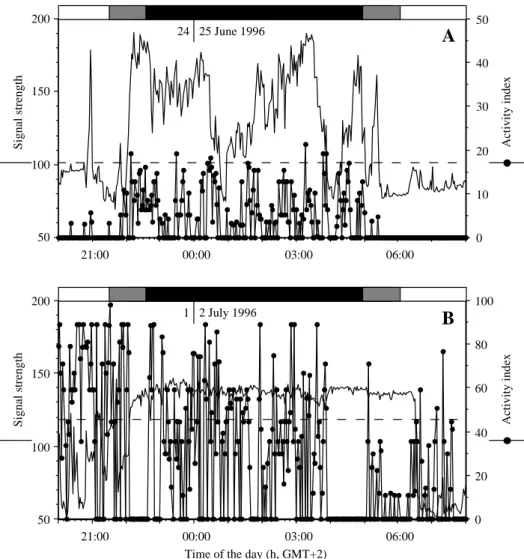© 1998 Kluwer Academic Publishers. Printed in Belgium.
Seasonal variations in time and space utilization by radio-tagged yellow
eels Anguilla anguilla (L.) in a small stream
E. Baras, D. Jeandrain, B. Serouge & J. C. Philippart
University of Li`ege, Laboratory of Fish Demography and AquacultureMailing address: Chemin de la Justice, 10 B-4500 Tihange, Belgium; E-mail: E.Baras@ulg.ac.be
Key words: home range, diel activity, foraging, behaviour, eel, Anguilla anguilla
Abstract
Seven yellow eels (572–643 mm, 318–592 g) Anguilla anguilla (L.) were tagged with surgically implanted radio transmitters (activity circuit, 1.6–1.7 g) and tracked in the Awirs stream, a small (width < 5 m, depth from 0.1 to 1.2 m), densely populated (ca. 250 kg of eel ha−1) tributary of the Belgian River Meuse. The eels were positioned daily from late April to mid-August, and their diel activity was studied during twenty four 24-h cycles. During day-time, the eels were resting in rootwads or in crevices inside stone walls or in crevices in between rocks. They became more active in the late afternoon but generally did not leave their residence before sunset, except under overcast weather. Activity peaked during the first part of the night then progressively vanished, and always ended before sunrise. The area exploited during night-time never extended over more than 40 m2, except when the eel changed its residence. The intensity and timing of nocturnal activity and the extent of the daily activity area were dependent on water temperature (respectively P < 0.0001, P < 0.05 and P < 0.0005), with eels showing little or no activity when the diurnal temperature did not exceed 13◦C. Eels showed higher agitation under full moon and maintained their activity later in the night (P < 0.05). The eels showed restricted mobility, and occupied small stream areas (from 0.01 to 0.10 ha) in a non sequential mode, except for two fish which were displaced to the River Meuse by a spate in early June and were never recovered. The length and frequency of net daily journeys were higher (P = 0.005) at water temperatures above 16◦C in late May and June, which also corresponded to the period of immigration of eels from the River Meuse. This study thus shows that large yellow eels may adopt a highly sedentary lifestyle in a continental, fast flowing and densely populated environment, even at periods of the year when these stages usually show upstream migrations.
Introduction
Due to its amphibiotic catadromous life cycle and huge migration distances in sea and fresh water, the European eel Anguilla anguilla (L.) has intrigued sci-entists for centuries (Sinha & Jones, 1975; Tesch, 1977; Deelder, 1984; McDowall, 1988). The recent decline of eel stocks revealed by the glass and silver eel fisheries (Brusle, 1989; Moriarty, 1990; Knights et al., 1996) further urges the need for providing more accurate information on their ecology. Eels are dis-crete animals, which essentially move at night and exhibit cryptic habits during daytime. These traits make them difficult to capture and observe in the wild, except at obstacles in estuaries and rivers, where traps
at fish passes are frequently used to document the seasonal periodicity and intensity of their migration (Moriarty, 1986; Legault, 1987; Baras et al., 1996). Outside of this particular context, the study of time and space utilization by eels can hardly be achieved by methods other than biotelemetry (Winter, 1983; Priede & Swift, 1992; Baras & Philippart, 1996).
Biotelemetry techniques have been used to study the movements of silver eels A. anguilla or A. rostrata (Lesueur) in estuaries and coastal waters (Stasko & Rommel, 1974; Nyman, 1975; Helfman et al., 1983; Parker, 1995), in the open sea (Tesch, 1974) and their migration from the continental shelf to the deep sea (Tesch, 1978, 1979). Paradoxically, whilst the fresh
N A B C D E F G H J I K L M N Eel 1 Eel 2 Eel 3 Eel 6 Eel 5 Eel 7 Eel 4 T° data logger River Meuse 0 40 20 60km North Sea France The Netherlands Germany Luxemburg R. Meuse
A
B
0 5 10 15 20 25 30 35 40 45 Stream area 0 1 2 3 4 5 6 7 8 9 A B C D E F G H I J K L M N Eel density (N / are) Eel biomass (kg / are)C
BELGIUM 0 100 mFigure 1. A. Location of the Awirs stream in Southern Belgium. B. Morphology of the study area, upstream of the confluence with the River
Meuse in Engis; open squares correspond to tunnels under road bridges; the arrows indicate the sites of release of radio-tagged eels (1 to 7). C. Population density of eels in May 1996, in sectors A to N, delimited by transverse bars on map B, as determined by electric fishing and mark recapture experiments.
water stages represent more than 80% of the life cy-cle of eels, few telemetry studies have documented their ecology in fresh water ecosystems. Lake studies were conducted on A. anguilla in Sweden (Wester-berg, 1982) and Spain (LaBar et al., 1987) and on A. rostrata in Vermont (USA; LaBar & Facey, 1983). The only detailed studies in riverine ecosystem were these by Dutil et al. (1988) on A. rostrata in a tributary of the Saint-Laurent River (Canada), and by McGov-ern & McCarthy (1992) on A. anguilla in River Clare (Ireland). Both sites were only a few kilometres away from the sea.
This study aimed to investigate the behavioural ecology (home range, activity rhythm patterns, effect of environmental factors on mobility) of yellow eels A. anguilla in a typical riverine fast flowing ecosystem, beyond any possible influence by lacustrine or marine ecosystems.
Study area
The study was conducted in Southern Belgium, in the lower reaches of the Awirs stream, from 0.1 to 1.2 km upstream of the confluence with the River Meuse in Engis (225 km from the estuary in the Netherlands). In this area, which is typical of the trout zone (Huet, 1949), the stream width and depth range from 1.75 to 4.50 m, and from 0.10 to 1.20 m, respectively. Fast flowing (≥ 50 cm s−1) riffles and rapids alternate with pools and glides, with an average distance of 30 m between consecutive morphodynamic units. The limits between some morphodynamic units have been arti-ficially enhanced by the construction of small weirs, with less of 40 cm of difference in height. Cobble and stone (10–30 cm) are the most frequent substrata (≥ 75%). The stream is lined by straight vertical banks (0.3 to 2.0 m high) which have been changed into stone walls over more than 60% of their length, as a
pre-ventive measure against flooding where it crosses the suburbs of Engis.
The fish community in the study area was analysed from electric fishing surveys before the tracking study and was found to contain 15 fish species, of which the most abundant were, in decreasing order of im-portance: the stone loach Barbatula barbatula (L.), the European eel, the gudgeon Gobio gobio (L.) and the roach Rutilus rutilus (L.). The size and weight of resident eels in spring 1996 averaged 477 mm (200– 768 mm) and 215 g. Their density and biomass was estimated by mark recapture at 11.8± 0.2 eels a−1, and 2.54± 0.04 kg a−1. The variation of eel density and biomass within the study area is illustrated in Figure 1C.
Material and methods
The eels used in this study were captured by DC electric fishing (EPMC, 2.5 kVA) in the aforemen-tioned stretch of the Awirs stream during spring 1996. Experimental animals were selected based on sev-eral criteria. Eels from the upstream reaches were preferred to those of the downstream reaches (A–C, Figure 1B) which crossed urban areas. We always se-lected eels longer than 55 cm and weighing more than 275 g to make sure that the transmitter to body weight ratio in the air would not exceed 0.6% (Baras & Je-andrain, 1998, this volume). The transmitters were 40 MHz motion-sensitive units with internal coiled an-tenna (ATS Inc. model 377, current drain of 0.03 mA, minimum expected battery life of 20–25 d), with car-rying frequencies separated by 10 kHz intervals. They measured 18 mm in length by 8 mm in diameter and weighed 1.6–1.7 g in air. The transmitters were tuned to transmit at a pulse rate of 40± 1 or 63 ± 1 pulses per minute, depending on the orientation of the fish (corresponding interpulse intervals of 1500 and 952 ms, respectively). Each fast movement or di-rection change of the fish caused the signal to shift from one pulse rate to the other. Transmitters were im-planted via a mid ventral incision into the body cavity of fish anaesthetised with 2-phenoxy-ethanol (0.9 ml l−1). The incision was closed with commercial grade cyanoacrilate adhesive, with a freshly cut fragment of eel’s fin applied as a biological bandage on the drying adhesive, according to the procedure recently evaluated by Baras and Jeandrain (op. cit.).
Tagged eels were released at their capture site less than one hour after surgery to minimise the possible
trauma and stress resulting from long term confine-ment (Parker, 1995; Baras et al., 1998). They were positioned at least once a day during daytime until the end of the transmitter battery life. Locations were made by triangulation from markers at 5–10 m inter-vals on the banks of the river, using a Fieldmaster receiver and diamond antenna (ATS Inc.) equipped with a compass. Due to the high conductivity of the Awirs stream (800–900 µS cm−1), the low power of transmitter and the cryptic behaviour of eels, the re-ception range could be cut down to less than 5 m during daytime. This forced the observer to move very close to the fish but permitted accurate position-ing. Water temperature was automatically recorded at 15 min intervals throughout the study with a datalog-ger (0.1 ◦C resolution; ControlOne) installed in the centre of the study area. Water level was measured at least once a day on a limnimetric scale installed at the temperature logger site.
The diel movement pattern of eel was analysed during twenty four 24-h cycles, from 3 May to 8 July, 1996. Fish were positioned at 10 min intervals and activity indices were measured in between, over 1 min intervals. Activity indices were deduced from the changes of pulse rates from the motion sensitive transmitters, which were all tuned at interpulse inter-vals of 952 and 1500 ms. Consequently, the maximum possible numbers of variations of pulse rate over one minute would be 49 (i.e. for a transmitter systemati-cally changing from one pulse rate to the other over this period) and would be granted an activity index of 100%. Lower number of changes in the pulse rates were given proportionally lower indices, with a min-imum of 0 for a transmitter constantly producing the same pulse rate (fast or slow) over one minute. An au-tomatic listening station (Lotek SRX-400), connected to a fixed diamond antenna, has also been used to con-tinuously record the variations of signal strength and pulse rate of eels over 24 h cycles. Due to the very weak power of transmitters, high water conductivity, intense jamming of radio signals by local industries, and additional loss of up to 12 dB when automatically recording pulse rate intervals, its use was restricted to extremely good conditions of signal propagation (five cycles in June and July). During 24 h cycles with the automatic listening station, the antenna was oriented all day round in the same direction, which permitted to discriminate, from signal strength variations, the times when the eel would leave its cryptic residence place and swim in open water. The observer
addition-Table 1. Characteristics of the radio-tagged eels in the Awirs stream. TBWR is the transmitter to body weight
ratio in the air.
Eel Body Tracked in 1996 Cause of Recapture by
n◦ Length Weight TBWR From To Days tracking end electric fishing
(mm) (g) (%)
1 585 467 0.35 28 Apr 08 Jun 40 Down to Meuse None
2 585 373 0.44 28 Apr 29 May 31 Battery 15 May
3 564 385 0.43 28 Apr 21 Jun 54 Battery 05 Jun
4 643 592 0.28 06 Jun 08 Jun 3 Down to Meuse None
5 574 453 0.36 06 Jun 18 Jul 42 Battery 27 Jun, 18 Jul
6 614 431 0.38 06 Jun 17 Jul 41 Battery 27 Jun, 18 Jul
7 572 318 0.52 27 Jun 03 Aug 37 End of study 18 Jul
ally located the fish at regular intervals to measure the extension of its daily activity area.
Results
Seven eels have been tagged from 28 April to 3 August, 1996 (Table 1; Figure 1B). The transmit-ters lasted up to 54 d and permitted to measure 248 eel-days observations and 241 net daily journeys (n-1 observation, for each of the seven eels). All eels showed restricted movements during the tracking pe-riod (Figure 2). Their home range did not extend over more than 285 m (0.1 ha), except for eels n◦1 and 4, which descended into the River Meuse during a freshet on June 8th, when the water level rose by about 1 m following a summer rainstorm. Despite intensive re-search during the following weeks, both downstream and upstream of the study area, these two fish were never recovered.
Eels showed contrasted mobility and space utiliza-tion patterns. During the first tracking days, four of the seven eels (n◦ 1, 4, 6 and 7) consistently occu-pied sites at less than 5 m from their release site. By contrast, eels n◦2 and 3 were located 40–50 m down-stream on the day following their release whilst eel n◦5 moved 100 m upstream then was displaced down-stream during the freshet. Eels n◦1 and 2 occupied almost sequentially their home ranges and travelled over the longest distance on the same day (May 27). The journey of eel n◦2 was much longer and extended its home range to 285 m, presumably because the eel was crossing habitats with low suitability, as suggested by the very low estimates of population density within these sectors (J and K, Figure 1C). Eel n◦ 7 consis-tently remained in the site when it was released, except
for two short excursions upstream, which were fol-lowed by homing movements. Eels n◦ 5 and 6, and to a lesser extent eel n◦3, utilised their home range in a radiative way, with upstream and downstream ex-cursions followed by returns to residences previously occupied (Figure 2). The diurnal residences areas used by radio-tagged eels essentially corresponded to highly structured, cryptic habitats, such as burrows or cavities inside stone walls, boulder assemblages, root-wads or undercut banks (Figure 3). On one occasion only, an eel rested in an open habitat where it ob-viously burrowed into the deep silt substratum. The small regulation weirs in the stream apparently were frequently used as residences by eels but represented no obstacle to their mobility, as they cleared them at low water level (Figure 2).
Amongst the 241 daily journeys of eels, 128 (53.1%) were null and 76 others (31.5%) less than 10 m. The longest journeys corresponded to the two downstream migrations to the River Meuse under ex-ceptionally high floods on June 8th. Except for this particular day, the water level varied very little in the Awirs stream, due to the regulation by the small weirs, and had no marked influence on the mobility of eel. The influence of thermal variables is illus-trated in Figure 4. Eels showed higher mobility under higher temperatures, and proportionally higher when the water temperature was increasing or decreasing by more than 1◦C between consecutive days, than during periods with little variation.
Eels showed a marked nocturnal activity pattern throughout the study. During daytime, they were con-sistently located inside their cryptic residence, which strongly reduced the strength of radio signals (Fig-ure 5). During the late afternoon, high activity indices
Figure 2a. Daily locations of radio-tagged eels with respect to their capture/release site, sited at 0 on the Y axis. For each tracking period, the
daily variations of water temperature and level are illustrated on the lower graph. See also pp. 192 and 193.
were measured. As these were consistently associated to low signal strengths, they presumably corresponded to changes of position inside the highly structured res-idence (Figure 3). Temporary high signal strengths were occasionally measured during this period, but the eels usually did not leave their residence before sunset, except on cloudy and/or rainy days, or when the water level and turbidity were increasing (Table 2). Eels exploited daily activity areas that were
propor-tionally longer under variable water levels and high temperatures (stepwise multiple regression analysis, P = 0.0012 and P = 0.0014). In any case, the daily area did not extend over more than 10–15 m (ca. 40 m2), except when the eel moved to another part of the stream and changed its residence.
During night-time, periods of high activity alter-nated with periods of complete rest, either inside or outside of the residence (e.g. Figure 5). The first
activ-Distance to release site (m) Eel n°4 200 190 180 170 160 150 -100 -80 -60 -40 -20 0 20 Down to River Meuse Distance to release site (m) Eel n°5 200 190 180 170 160 150 0 50 100 150 200 Capture by electric fishing Distance to release site (m) Eel n°6 200 190 180 170 160 150 -80 -60 -40 -20 0 20 40 Capture by electric fishing 200 190 180 170 160 150 5 10 15 20 25 15 20 25 30 35 40 June 1996 July 1996
Date (Julian days)
Water temperature (°C) Spate (+75-80 cm) Water level (cm) Figure 2b. See p. 191.
ity period took place 5 to 35 min after the eel left its diurnal residence, and almost always was the most in-tense of the night. Later on, the activity progressively vanished, and always ended before sunrise. Both the duration and intensity of activity varied consid-erably during the study, depending on environmental variables, including the lunar cycle (Table 2). Eels exposed at the light of full moon had higher over-all activity indices than during other periods of the lunar cycle (Mann-Whitney U-test; U = 13, U0= 67, P = 0.034). Their activity under moonlight consisted in
short bursts, with most frequent changes of pulse rates but low variations of signal strength, that indicated a high degree of agitation, but over a most restricted area. This activity pattern contrasted with the more regular patterns observed during other nights (e.g. Fig-ure 5). During these cycles, the eels maintained their activity later in the night (U = 4, U0= 48, P = 0.013), after moonset. During nights with no influence of moonlight, the overall activity index was positively correlated with mean water temperature (Log–Log re-lationship, F = 53.4, R2= 0.750, P < 0.0001; n = 20),
Figure 2c. See p. 191.
Open (silt) Rocks Undercut earthen bank Rootwads Boulder assemblages at weirs Stone walls 0 10 20 30 40 50 60 Frequency (%)
Figure 3. Residence habitat utilization by radio-tagged eel in the Awirs stream in spring and summer 1996.
with eels showing little or no activity when the diurnal temperature did not exceed 13◦C. Water temperature also influenced the timing of activity: the nocturnal activity of eels ended sooner under a steep noctur-nal temperature decrease, and proportionoctur-nally sooner at lower temperatures (stepwise multiple regression analysis, P = 0.0096 and P = 0.0385, for temperature gradient and temperature at sunrise, respectively).
Discussion
All seven radio-tagged eels survived the surgical tag-ging procedure and consistently retained their trans-mitter throughout the study. The fish that were recap-tured by electric fishing more than three weeks after tagging, had healed their abdominal incision. Their sacrification at the end of the study (eels n◦ 2, 3, 5 and 6) revealed no internal damage resulting from the presence of the transmitter inside the body cavity. The low mobility of eels n◦1, 2 and 3 during the two first tracking weeks (before the incision had healed) may
Table 2. Characteristics of 24 h cycles of activity of radio-tagged eels in the Awirs stream in spring-summer 1996. The duration of activity
corresponds to the running sum of periods when eels showed activity (at least one change of pulse rate 1R min−1) and the mean activity index is calculated from the ratio (%) of active records over these periods. The overall activity index is the product of the two latter variables, and is expressed as the ratio (%) over a 24-h cycle. For eels which apparently remained at the same site during the whole tracking cycle, the extension of the daily activity area is set as the accuracy of the positioning at close range (0.5 m). The symbol∗ indicates that the activity area of the eel was illuminated by full moon light.
Date (1996) Water T◦ Water Eel Start at (min End at (min Duration Mean Overall Extension (◦C) level n◦ before (−)/after before (−)/after activity of activity activity of daily
min–max (cm) (+) sunset) (+) sunrise) (min) index index activity
(%) (%) area (m) 03–04 May 10.1–13.6 27± 8.0 2 20:20 (− 47) 05h40 (− 32) 215 13.3 2.0∗ 12.5 09–10 May 8.2–12.3 19± 0.5 1 – – 0 0.0 0.0 0.5 12–13 May 10.7–11.0 21± 0.5 1 – – 0 0.0 0.0 0.5 16–17 May 9.8–11.5 19± 0.0 1 04:00 (+ 353) 04:30 (− 82) 30 8.2 0.2 3.0 2 – – 0 0.0 0.0 0.5 3 – – 0 0.0 0.0 0.5 20–21 May 10.6–13.8 19± 0.0 1 – – 0 0.0 0.0 0.5 2 20:00 (− 93) 23:55 (− 352) 80 10.9 0.3 9.0 3 – – 0 0.0 0.0 0.5 26–27 May 12.5–14.1 22± 6.0 1 19:30 (− 130) 03:10 (− 149) 200 8.7 1.2 10.0 2 21:30 (− 10) 05:00 (− 39) 180 8.9 1.1 13.0 01–02 June 12.4–16.2 21± 0.5 1 21:50 (+ 3) 02:20 (− 195) 150 14.7 1.5 2.0 3 22:35 (+ 48) 05:25 (− 10) 185 32.2 4.1∗ 7.0 11–12 June 16.3–20.1 18± 0.5 3 22:45 (+ 50) 01:52 (− 218) 180 14.9 1.9 8.0 5 22:16 (+ 21) 05:17 (− 13) 115 37.5 3.0 8.0 6 22:30 (+35) 04:10 (− 80) 185 25.5 3.3 80.0 18–19 June 13.2–17.5 18± 0.5 5 22:23 (+ 24) 03:10 (− 139) 135 35.4 3.3 10.0 6 22:24 (− 25) 23:35 (− 354) 75 26.5 1.4 8.0 24–25 June 12.4–13.1 19± 0.5 5 – – 0 0.0 0.0 0.5 6 22:05 (+ 5) 04:55 (− 35) 236 9.0 1.5 8.0 01–02 July 12.9–14.6 20± 1.0 5 22:35 (+ 36) 04:35 (− 59) 110 16.0 1.2∗ 6.0 6 01:15 (+ 196) 04:30 (− 64) 110 24.1 1.8 6.0 7 22:41 (+ 42) 05:32 (− 2) 244 50.2 8.5∗ 8.0 08–09 July 12.8–15.1 20± 0.5 7 22:18 (+22) 04:00 (− 100) 240 16.3 2.7 3.0
be regarded as a consequence of the tagging proce-dure. However, the comparison with eels n◦4, 5 and 6, which all moved over much longer distances within the first tracking days, suggests that this low mobility presumably was a consequence of low water temper-ature at that time of the year. These observations on wild fish in natural environments substantiate the ad-equacy of surgical tagging and incision closing with cyanoacrilate adhesives (Baras & Jeandrain, 1998, this volume).
This study documented the highly sedentary lifestyle of yellow eels in streams, both at the sea-sonal and daily levels. They occupied home ranges from 0.01 to 0.10 ha, which were much shorter than most estimates reported in mark-recapture or
teleme-try studies on eels. Mann (1965) reported home ranges as long as 30 km for A. anguilla in the River Elbe (Germany) and Parker (1995) recently documented a mean summer home range of 325± 64 ha for A. ros-trata in a tidal estuary. Home ranges of A. rosros-trata and A. anguilla in lakes ranged from 2 to 65 ha (LaBar & Facey, 1983), and from 0.1 to 0.27 ha (LaBar et al., 1987), respectively. In salt marshes, A. australis (Richardson) and A. rostrata did not move over more than 400 m and 100 m, respectively (Beumer, 1979; Ford & Mercer, 1986). Studies in riverine ecosys-tems indicated home ranges of 0.5 to 2.0 ha for A. rostrata (Dutil et al., 1988), and of 0.1 to 0.6 ha for A. anguilla (McGovern & McCarthy, 1992). The dif-ference between these studies and ours presumably
Figure 4. Mobility of radio-tagged eel in the Awirs stream depending on ambient water temperature (T◦) and temperature variation between consecutive days (1T◦d–d−1). Values are means of net daily journeys (N = 241) of seven eels from late April to early August 1996 (2-way ANOVA; T◦: F = 6.39, P = 0.005; 1T◦(d-d−1): F = 7.92, P = 0.002; interaction: F = 4.89, P = 0.008).
originated from the small width and high complexity of the Awirs stream, which offered numerous refuges and did not force the eels to move over long distances to find alternative refuges. Chisnall & Kalish (1993), who studied the movements of A. australis and A. di-effenbachii (Gray) by mark recapture also concluded to small scale (< 140 m) movements in a small stream of New Zealand. Similarly, Gunning & Shoop (1962) observed that A. rostrata occupied home ranges of less than 50 m in small Louisiana streams but were using larger ranges in wider streams.
Beyond the relationship between stream width and home range size, the sedentary nature of yellow eels in this study may look surprising, as migration can take place at all stages of the life cycle and as eel populations are usually considered as open (Mori-arty, 1983). However, several studies documented the fidelity of tagged eels to discrete refuges (Ford & Mer-cer, 1986; McGovern & McCarthy, 1992), as well as their precise homing abilities (A. anguilla, Rossi et al., 1987), even over distances exceeding 10 km (A. rostrata, Parker, 1995). These findings suggest some form of territoriality or at least attachment to precise loci, which can be interpreted within the context of optimal foraging strategies (Hart, 1986), i.e. eels ex-ploiting more efficiently an environment which they have already experienced. The attachment to precise loci may proportionally be higher in densely popu-lated environments, such as the Awirs stream, where the population density is sensibly higher than in most European waters (Tesch, 1977; Lobon-Cervia et al., 1990; Barak & Mason, 1992).
Variations of water levels were scarce in the Awirs stream and had no marked influence over daily jour-neys, except during the spate in early June when two eels were flushed down to the River Meuse. The rea-sons why these two eels did not home, whilst other eels (n◦3, 5, 6) displaced at shorter distances did, are unknown. Water temperature strongly influenced the movements of eels, which occupied restricted ranges and showed little or no diel activity when water tem-perature was below 12 ◦C. Several authors (Sinha & Jones, 1975; Tesch, 1977; Beumer, 1979; LaBar et al., 1987) already reported that eels had little or no activity at low temperatures. Comparatively, eels showed much more frequent and longer net daily jour-neys above than below 16◦C. This result is consistent with the observations by Sörensen (1950, in Deelder, 1984) and Moriarty (1986) who both found that yellow eels had no migratory activity below 14–15◦C. The higher mobility of ‘sedentary eels’ at higher tempera-tures may be regarded as a consequence of increasing energetic expenditures. The foraging activity of eels was longer, more intense and extended over a larger daily area when the water temperature was higher. This presumably resulted into a higher competition be-tween resident eels, especially in a densely populated stream. Higher mobility of eels at high temperature may also reflect another form of population density pressure, due to the arrival of immigrants from the River Meuse, the ascent of which is also dependent on water temperature (Baras et al., 1996). Indeed, the periods when radio-tagged eels showed most frequent daily journeys (June 1996) precisely corresponded to the period of migration of yellow eels in the River
06:00 03:00 00:00 21:00 50 100 150 200 0 20 40 60 80 100 50 100 150 200 0 10 20 30 40 50 24 25 June 1996 1 2 July 1996
A
B
Signal strength Activity index
Time of the day (h, GMT+2)
Signal strength Activity index
06:00 03:00
00:00 21:00
Figure 5. Illustration of diel activity of radio-tagged yellow eel in the Awirs stream in 1996, recorded by an automatic data-logging telemetry
receiver. A. eel n◦6 on 24–25 June. B. Eel n◦7 on 1–2 July, under full moon. Signal strengths above the dotted line correspond to eels in open water, and below the dotted line to eels inside their cryptic residence (crevice in stone walls or in between rocks), which strongly reduces the signal strength. The activity index is proportional to the number of changes of pulse rates of activity transmitters over a 1 min interval (see methods). No activity index higher than 10% and no movement outside the residence between 08:00 and 20:00.
Meuse and to their immigration in the Awirs stream (Baras & Jeandrain, unpublished).
Consistent with the results of laboratory (Westin & Nyman, 1979), field trapping (Sorensen et al., 1986; Baras et al., 1994) or tracking studies (Helfman et al., 1983; LaBar & Facey, 1983; LaBar et al., 1987; Mc-Govern & McCarthy, 1992; Parker, 1995), yellow eels in the Awirs stream almost exclusively moved at night and always ended their activity before sunrise. Some eels left their diurnal residence before sunset, but only under low light conditions (rain, dark cloudy sky). McGovern & McCarthy (1992) had already provided evidence that the diurnal swimming speeds of eels during overcast weather were similar to those during
night-time. Ernande (1995) and Parker (1995) also re-ported the diurnal activity of eels under cloudy days. These results, as well as the selection of cryptic, highly structured refuges, corroborate the colloquial belief that eels are photophobic animals. As day light can hardly penetrate inside these refuges, eels may have little or no information on the light intensity in their daily activity area. This situation may account for the high activity indices measured during the late after-noon, when eels presumably made short movements at the limit of their residence, which were aborted until the light intensity decreased to a level similar to that at sunset. McGovern & McCarthy (1992) found that the swimming activity of eels was discontinuous, with
sequences of continuous swimming lasting from 4 to 35 min, but never exceeding 6% of the tracking time. The activity of eels in the Awirs stream was consistent with this observation, except during the first part of the night, when eels could be active more than one hour in a row. This early nocturnal peak of activity during spring and summer may be interpreted within a mo-tivational context, as the hunger stimulus presumably was very high for fish which had not been foraging since sunrise (ca. 16 h before).
The examination of faeces of fish captured by electric fishing revealed that eels were feeding on in-vertebrates, and essentially on small molluscs. This may partly explain the nature of the relationship be-tween the lunar cycle and eel’s activity in the Awirs stream. The moonlight at the full moon is known to depress the activity of benthic invertebrates (e.g. Neveu & Echaubard, 1975). This reduced prey avail-ability may force foraging fish, the appetite of which is basically dependent on ambient water temperature, to be active for longer periods at full moon, even if these fish are photophobic (e.g. Barbus barbus (L.); Baras, 1992; 1995). However, the very short and in-tense bursts of activity over a restricted area under full moon, and the observation of eels showing additional activity in the late night, after moonset, both suggest that eels were not feeling comfortable under moon-light. This activity pattern may be compared with the observations of Ernande (1995) who also found that eels were travelling short distances under full moon and showed higher activity in the late night, and of McGovern & McCarthy (1992), who reported that eels were swimming three to four times faster under bright conditions than in darkness, presumably because they were feeling less comfortable under higher light inten-sity. The precise reason why eels chose to be active under uncomfortable conditions remains to be inves-tigated. It may originate from a high hunger stimulus at sunset and relatively short time for foraging during summer nights, especially in a densely populated en-vironment, where eels presumably compete for food. Further studies at different population densities and periods of the year could bring additional information to substantiate or invalidate this interpretation.
Conclusions
This study provided evidence that large eels may adopt a highly sedentary lifestyle in a continental, fast flowing and densely populated environment, even
at periods of the year (spring-summer) when these stages usually show upstream migrations. This find-ing, along with the home-site fidelity documented by displacement experiments (Parker, 1995), should be considered when establishing environmental man-agement policies. The day-by-day positioning and minute-by-minute monitoring of activity patterns of eels by manual or automatic telemetry also permitted a better understanding of the influence of environ-mental variables on the way yellow eels utilise their environment. The finding that eels may be highly sedentary further increases the opportunity to automat-ically monitor the behaviour of radio-tagged fish over longer periods, and to analyse the adequacy of their time and space utilization strategies, i.e. testing for the consistency of activity patterns over consecutive 24 h cycles and investigating the growth rates of eels with different activity or home range patterns. With the continuous transmitting units used in this study, it was not possible to track eels over periods longer than 8 weeks. In the future, we intend to use program-mable transmitters operating with duty cycles in order to document the mobility patterns of eels in the long run.
Acknowledgements
The ‘eel’ research programme was supported by the Commission Provinciale de Liège du Fonds Piscicole’, coordinated by J. C. Philippart (FNRS). The authors wish to thank M. Ovidio, C. Birtles, L. Hill, G. Rim-baud, F. Giroux and G. Bataille who participated in the electric fishing and tracking surveys. We are indebted to the inhabitants of Engis who kindly permitted us to access their private properties when tracking eels. References
Barak, N. A. E. & C. F. Mason, 1992. Population density, growth and diet of eels, Anguilla anguilla L., in two rivers in eastern England. Aquacult. Fish. Mgmt. 23: 59–70.
Baras, E., 1992. Etudes des stratégies d’occupation du temps et de l’espace chez le barbeau fluviatile, Barbus barbus (L.). Cah. Ethol. 12: 125–442.
Baras, E., 1995. Seasonal activities of Barbus barbus: effect of temperature on time-budgeting. J. Fish Biol. 46: 806–818. Baras, E. & D. Jeandrain, 1998. Evaluation of surgery procedures
for tagging eel Anguilla anguilla with biotelemetry transmitters. Hydrobiologia 371/372: 107–111.
Baras, E. & J. C. Philippart (eds), 1996. Underwater Biotelemetry. University of Liège, Belgium, vi + 257 pp.
Baras, E., J. C. Philippart & B. Salmon, 1996. Estimation of migrant yellow eel stock in large rivers through the survey of fish passes: a preliminary investigation in the River Meuse (Belgium). In I.G.
Cowx (ed), Stock Assessment in Inland Fisheries. Fishing News Books, London: 83–92.
Baras E., B. Salmon & J. C. Philippart, 1994. Evaluation of a eel trap sampling method for the assessment of migrant yellow eels
Anguilla anguilla (L) in the River Meuse. Bull. fr. Pêche Piscic.
335: 7–16.
Baras, E., C. Birtles, L. Westerloppe, X. Thoreau, M. Ovidio, D. Jeandrain & J. C. Philippart, 1998. A critical review of surgery techniques for implanting telemetry devices into the body cavity of fish. In Y. Le Maho (ed.), Proceedings of the 5th European Conference on Wildlife Telemetry. Strasbourg, France, 26–30 August 1996, in press.
Beumer, J. P., 1979. Feeding and movement of Anguilla australis and A. reihnardtii in Macleods Morass, Victoria, Australia. J. Fish Biol. 14: 573–592.
Brusle, J., 1989. L’anguille européenne (Anguilla anguilla), une es-pèce jugée commune jusqu’à la dernière décennie, mérite-t-elle d’acquérir aujourd’hui le statut d’espèce menacée? Bull. Soc. zool. France 114: 61–70.
Chisnall, B. L. & J. M. Kalish, 1993. Age validation and movement of freshwater eels (Anguilla dieffenbachii and A. australis) in a New Zealand pastoral stream. New Zealand J. mar. freshw. Res. 27: 333–338.
Deelder, C. L., 1984. Synopsis of biological data on the eel Anguilla
anguilla (Linnaeus, 1758). FAO Fish. Synopsis 80: 73 pp.
Dutil, J. D., A. Giroux, A. Kemp, G. Lavoie & J. P. Dallaire, 1988. Tidal influence on movements and daily cycle of activity of American eels. Trans. am. Fish. Soc. 117: 488–494. Ernande, B., 1995. Etude du rythme d’activité de l’anguille
eu-ropéenne Anguilla anguilla L. en marais maritime par télémétrie acoustique. M.S. Thesis, CNRS Ifremer, 41 pp. + ann. CREMA l’Houmeau, Place du Séminaire, BP 5, F-17137 L’Houmeau, France.
Ford, T. E. & E. Mercer, 1986. Density, size distribution and home range of American eels, Anguilla rostrata, in a Massachusetts salt marsh. Envir. Biol. Fishes 17: 309–314.
Gunning, G. E. & C. R. Shoop, 1962. Restricted movements of the American eel, Anguilla rostrata (LeSueur), in freshwater streams with comments on growth rate. Tulane Stud. Zool. 9: 265–272. Hart, P. J. B., 1986. Foraging in teleost fishes. In T. J. Pitcher (ed.),
The behaviour of teleost fishes. Croom Helm, London: 211–235. Helfman, G. S., D. L. Stoneburner, E. L. Boseman, P. A. Chris-tian & R. Whalen, 1983. Ultrasonic telemetry of American eel movements in a tidal creek. Trans. am. Fish. Soc. 112: 105–110. Huet, M., 1949. Aperçu de la relation entre la pente et les pop-ulations piscicoles des eaux courantes. Schweiz Z. Hydrol. 11: 332–351.
Knights, B., E. White & L. A. Naismith, 1996. Stock assessment of European eel, Anguilla anguilla L. In I. G. Cowx (ed.), Stock Assessment in Inland Fisheries. Fishing News Books, London: 431–447.
LaBar, G. W. & D. E. Facey, 1983. Local movements and inshore population sizes of American eels in Lake Champlain, Vermont. Trans. am. Fish. Soc. 112: 111–116.
LaBar, G. W., J. A. Hernando Casal & C. Fernandez Delgado, 1987. Local movements and population size of European eels, Anguilla
anguilla, in a small lake in south-western Spain. Envir. Biol.
Fishes 19: 111–117.
Legault, A., 1987. L’anguille dans le bassin de la Sèvre niortaise. Publ. Dépt. Halieut. Ecole Nat. Sup. Agro. Halieut. 6: 295 pp., Nantes, France.
Lobon-Cervia, J., Y. Bernat & P. A. Rincon, 1990. Effects of eel (Anguilla anguilla L.) removals from selected sites of a stream on its subsequent densities. Hydrobiologia 206: 207–216.
Mann, H., 1965. Über das rückkehrvermogen verpflantzer fluss-aal. Arch. Fischereiwissenschaft 15: 177–185.
McDowall, R. M., 1988. Diadromy in fishes. Croom Helm, London, 308 pp.
McGovern, P. & T. K. McCarthy, 1992. Local movements of fresh-water eels (Anguilla anguilla L.) in western Ireland. In I. G. Priede & S. M. Swift (eds), Wildlife Telemetry: Remote Sens-ing and MonitorSens-ing of Animals. Ellis Horwood, Chichester, UK: 319–327.
Moriarty, C., 1983. A population study of the eel Anguilla anguilla in Meelick Bay, Lough Derg. Fish. Bull. Dublin 7: 1–8. Moriarty, C., 1986. Riverine migration of young eels Anguilla
anguilla (L.). Fish. Res. 4: 43–58.
Moriarty, C., 1990. European catches of elver of 1928–1988. Int. Rev. Ges. Hydrobiol. 75: 701–706.
Neveu, A. & M. Echaubard, 1975. La dérive estivale des invertébrés aquatiques et terrestres dans un ruisseau du Massif Central: la Couze Pavin. Ann. Hydrobiol. 6: 1–26.
Nyman, L., 1975. Behaviour of fish influenced by hotwater efflu-ents as observed by ultrasonic tracking. Rep. Inst. freshwat. Res. Drottningholm 54: 64–74.
Parker, S. J., 1995. Homing ability and home range of yellow-phase American eels in a tidally dominated estuary. J. mar. biol. Ass. U.K. 75: 127–140.
Priede, I. G. & S. M. Swift (eds), 1992. Wildlife Telemetry: Re-mote Sensing and Monitoring of Animals. Ellis Horwood Ltd., Chichester, UK, 708 pp.
Rossi, R., M. Bianchini, A. Carrieri & P. Franzoi, 1987. Ob-servations on movements of yellow eels Anguilla anguilla af-ter displacement from coastal waaf-ters to sea. J. Fish Biol. 31: 155–164.
Sinha, V. R. P. & J. W. Jones, 1975. The European freshwater eel. Liverpool University, Liverpool, 146 pp.
Sörensen, J., 1950. An investigation of some factors affecting the upstream migration of the eel. Rep. Inst. freshwat. Res. Drottningholm 32: 126–172.
Sorensen, P. W., M. L. Bianchini & H. E. Winn, 1986. Diel forag-ing activity of American eels, Anguilla rostrata (LeSueur), in a Rhode Island estuary. Fish. Bull. 84: 746–747.
Stasko, A. B. & S. A. Rommel Jr., 1974. Swimming depth of adult American eels (Anguilla rostrata) in a saltwater bay as determined by ultrasonic tracking. J. Fish. Res. Bd Can. 21, 1148–1150.
Tesch, F. W., 1974. Speed and direction of silver and yellow eels,
Anguilla anguilla, released and tracked in the open North Sea.
Ber. dt. wiss Kommn. Meereforsch. 23: 181–197.
Tesch, F. W., 1977. The Eel. Biology and Management of Anguillid Eels. Chapman & Hall, London.
Tesch, F. W., 1978. Telemetric observations on the spawning mi-gration of the eel (Anguilla anguilla) west of the European continental shelf. Envir. Biol. Fishes 3: 203–209.
Tesch, F. W., 1979. Tracking of silver eels (Anguilla anguilla) in different shelf areas of the Northeast Atlantic. Rapp. P.V. Réun. Cons. Explor. Mer 174: 104–114.
Westerberg, H., 1982. Ultrasonic tracking of migrating eels in Lake Hjaelmaren. Rep. Inst. freshw. Res. Drottningholm 7, 1–22. Westin, L. & L. Nyman, 1979. Activity, orientation and migration of
Baltic eel (Anguilla anguilla L.). Rapp. Cons. Explor. Mer 174: 115–123.
Winter, J. D., 1983. Underwater biotelemetry. In L. A. Nielsen & J. D. Johnsen (eds), Fisheries Techniques. American Fisheries Society, Bethesda, Maryland: 371–395.
